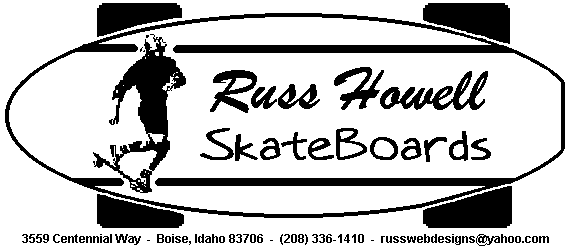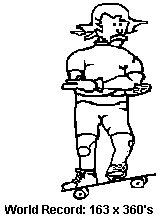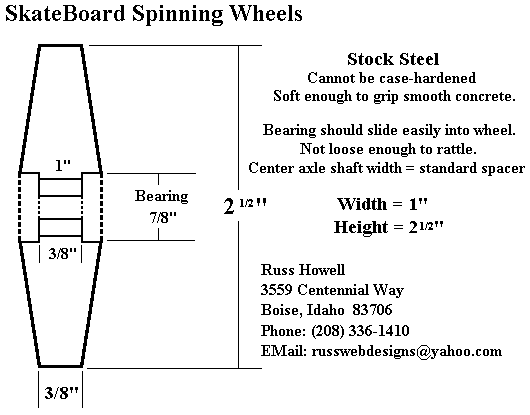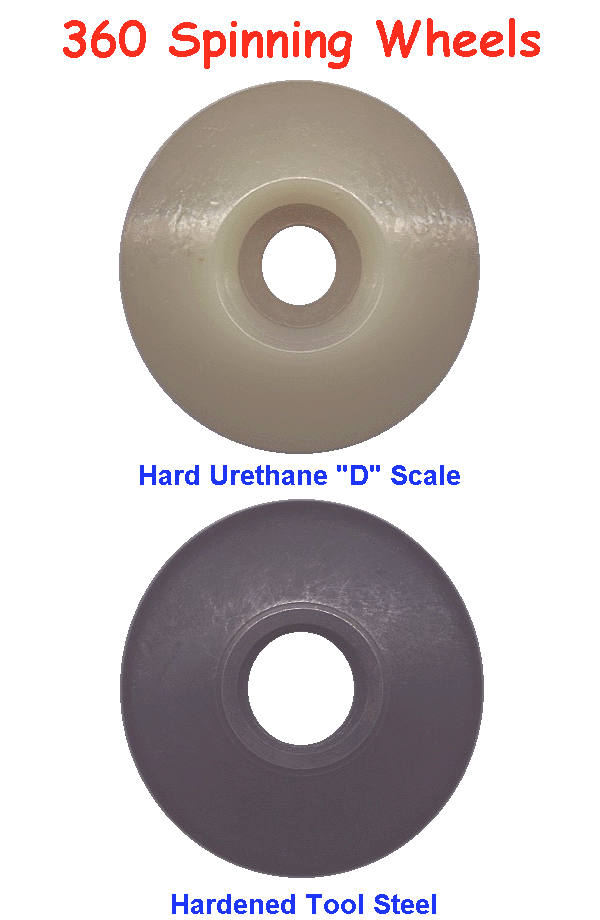Skateboard 360 Spinning Tips
Download Skateboard 360 Spinning Tips (Text File=10kb)
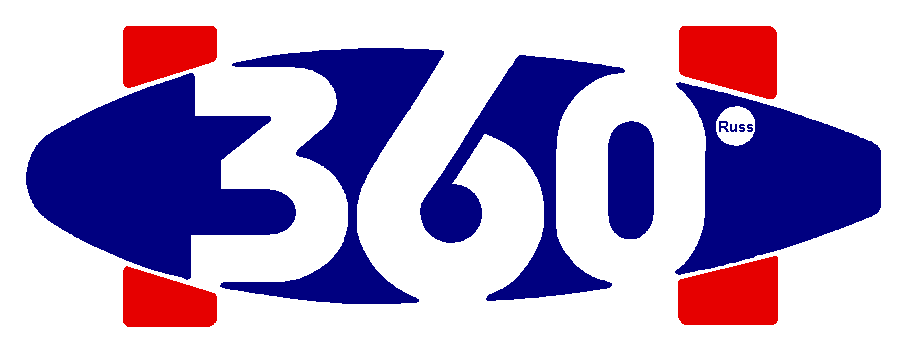
Philosophy of Acquisition and Sharing
I believe it is good to share everything with others.
Plato: "Poverty is not the diminishing of one's possessions, but rather the increase of one's greed."
The motivation to gain knowledge, possessions, power and fame varies for every individual.
I was studying at California State University of Long Beach to become a Physical Education teacher in 1975 when I was asked by Long Beach Parks and Recreation to teach a skateboarding class.
My students learned quickly and I was soon faced with the question of whether to teach them everything I knew, or hold back and maintain a prideful superiority.
The decision was easy and also enlightening.
My own skills and opportunities began to soar immediately after I confirmed my dedication to use all that I had to benefit others.
The 1975 Del Mar Bahne/Cadillac Nationals were held in the Spring and my students encouraged me to enter.
I won the title of National FreeStyle Champion and began my professional skateboarding career.
My ability to spin was never motivated by pride, but rather to see how far I could push the limits of my sport.
I share the following Skateboard 360 Spinning Tips so that others may learn from my observations and push the limits of skateboarding even higher.
It would cause great personal satisfaction to know that someone else was able to use my experience as a stepping stone to reach greater heights than I have acquired
- Knowledge: The cognitive awareness that something exists or can be done.
- Learning: A change in behavior enabling someone to replicate a specific action.
- Wisdom: The application of knowledge and/or learning to benefit others.
Skate Forever,
Russ Howell
Table of Contents
- Introduction To Spinning
- Spinning Technique
- Where To Start
- Arm Placement
- Overcoming Dizziness (Advanced Technique)
- Producing Perpetual Spins (Advanced Technique)
- Arm Movement
- Surface Considerations
- Equipment Considerations
- Making Softer Urethane Spinning Wheels To Learn On
- Commercially Manufactured Wheels
- YouTube Spinning Video
Introduction To Spinning
- Every skill requires: speed, timing and accuracy.
- Speed is the last item you want to concern yourself with in the learning stages.
- Concentrate on developing proper spinning form accuracy at first.
- Wheel selection is critical for high spins, but almost any wheel will reach ten spins.
- Building a good spinning foundation is the most difficult part of learning.
- Once you get up to 15, your numbers will increase exponentially.
Spinning Technique
- There are only a handful of really great spinners in the world.
- Each person has developed their own technique, and it is obvious that there are multiple techniques that will work.
Where To Start
- Start your spin with your feet sideways on the board.
- Your feet should be wide apart for balance and power when starting the spin.
- Frontside spins are easier to learn, but backside spins will eventually produce higher numbers.
- Frontside spins allow you to drag your tail during the learning stages which makes this technique easier to learn at first.
- Backside spinning will produce higher spins because you can get more power from your arms in that direction.
- Don't bend or twist at the waist then spinning; keep your back straight in line with the axis of your rotation.
- Keep your upper body upright without bending or twisting as this will slow or stop your spin.
- Outstretch your arms and move them across your body in the direction of spin you want to go.
- When your arms come across and are directly in front of your chest, lift off the nose of your board.
- Do not lean back, but merely shift your weight so the front of the board lifts off the ground.
- I start with my feet wide apart until I get settled into my spin and then slide my feet closer together to conserve rotational energy.
- Remember, an object that rotates further from the axis of rotation will require more distance to complete each rotation and consequently require more force.
Arm Placement
- Once you have begun to spin, keep your arms outstretched until you gain your balance.
- Your arms are the source of your initial power.
- Your arms also control speed and balance during your spin.
- When your arms are outstretched, you will spin slower and each spin will drain more energy.
- Bringing your arms in will result in faster spins and require less energy for each spin.
- Remember, start off slow and learn control first.
- Speed and high numbers will follow after you establish your technique and balance.
- Your arms control speed by stretching them away from you, or bringing them in close to you.
- Your arms also control your body lean during your spin.
- If you feel yourself leaning backwards, drop your arms lower to correct.
- If you feel yourself leaning forwards, raise your arms higher to correct.
Overcoming Dizziness
- The traditional way to diminish the effects of spinning are to use a technique called "spotting."
- This requires you to snap your head around each spin so that your eyes can focus on a single point.
- This fools your mind into thinking that you are not spinning.
- Unfortunately, turning your neck many times is painful and not very effective.
- I have developed my own technique.
- During a spin, everything is out of focus, but this can be used to your advantage.
- Consider a record player with a strobe timing light.
- The record turns and you use the strobe light to adjust to the proper rotation speed.
- During my spins, I focus on the brightest light source which produces a blurred line of light as I spin.
- This light line can be used to judge your body position much like the pitch and yaw that an airplane pilot uses to maintain stability.
- By focusing on this blurred light line, I am focusing on the only visual constant; the blurred light line.
- Don't worry about this technique until you get to spins over twenty.
Producing Perpetual Spins
- I have also discovered that there are power points within the body that can help perpetuate spins.
- The wrists, neck and ankles can be snapped during spinning to help generate power and keep your spins going.
- These techniques can only be accomplished with many hours of practice.
Arm Movement
- Keep the rotation of your arms centered around your axis of rotation.
- Don't pull your arms in right away.
- Leave them extended until you gain your balance.
- I like to practice pulling my arms in and extending them out.
- I do this several times during a single spin to get used to varying speeds.
Surface Considerations
- Search for those smooth concrete surfaces.
- Make sure you sweep them clean.
- Morning is best when the concrete is cool. Hot surfaces spin slower.
- Don't spin on rough ground (especially blacktop asphalt).
- The surface should be flat. This is what is used for spinning competitions.
- A sloped surface will help you learn to adjust to varying angles and increase your ability to adapt to being off-balance.
- A sloped surface will also offer the advantage of providing potential energy from the vertical drop.
- While spinning on a sloped surface, drop the nose of the board slightly as you come around each time towards the downward slope of the hill.
- This will allow your board to drift downhill and gain more energy to keep your spins going.
- Slope spinning is the best way I know of to help you improve your spinning numbers.
- Remember, slope spinning is not a legal technique for setting world spinning records.
- My World Record of 163 spins was set on a perfectly flat surface.
Equipment Considerations:
Wheels
- If asphalt is all you have to spin on, then I suggest regular narrow soft urethane wheels.
- Don't wear out your high-performance spinners on practicing low numbers.
- High-performance spinning wheels are also more difficult to learn on.
- Any wheel will let you spin ten, so why not wear out inexpensive wheels instead of your expensive custom wheels that you may not be able to replace?
- High Performance Competitive Spinning wheels are harder than conventional wheels.
- Competitive Spinning Wheels are made out of a hard "D" scale urethane or preferably metal.
- These harder wheels will wear out quickly on rough surfaces.
- Spinning wheels are weight sensitive.
- Heavier wheels don't work as well as lighter wheels.
- Consider the wheels on a racing bicycle:
- The outer rims and tires have to be light weight so you don't displace a large amount of weight around the circumference as you travel.
- Remember: Work = Force x Distance.
- Weight that rotates around the axis takes up more energy and reduces the amount of spins with the same amount of Force.
- Make the spinning wheels exactly to the dimensions on my Web site.
- Do not make these wheels out of a heavy tool steel; use the softer steel.
- This will not only lighten the wheel allowing for more spins, but also increase the traction for faster take-offs.
Skateboard & Trucks
- I use a narrow board (homemade) with narrow trucks (4" old Lazers).
- If the trucks are wider, the wheels will have to travel a greater distance to complete each rotation.
- I put a small block on the top back of my board to keep my foot from slipping off during fast spins.
Bearings
- Make sure the bearings can easily fit into the wheel openings without much force.
- The bearings should fit snugly without wobble.
Making Softer Urethane Spinning Wheels To Learn On
- I've found that it's quite easy to modify existing soft urethane wheels into spinning wheels.
- I use a C-clamp to anchor my electric drill and then attach a regular skate wheel to a shaft which fits into the drill.
- Turn on the drill and use a hack saw to slowly cut away the outside edge of the wheel.
- You may have to do this in several steps as the urethane will heat up very quickly, melt and attach itself to the saw blade.
- Use a sharp saw blade and make sure the wheel is turning evenly on the drill shaft.
- Cut the wheel so it is only as wide as where the bearing have to fit into.
- A wheel with half the width will produce half the friction.
Commercially Manufactured Wheels
- I only made a dozen sets of these wheels as they last for a very long time.
- Shortly after designing the narrow wheels, the company that poured them for me sold wheels from the same mold to Hobie and marketed them as Richie Carrasco Spinners.
- He took credit for the design, but they were my same exact wheels without any modifications.
- Richie's a good guy, so I'm sure it was just a marketing oversight.
YouTube Spinning Video
YouTube - Russ Howell Spinning 97 360's - Posted December 15, 2006
http://www.youtube.com/watch?v=xV-mfUFLuIY
Taken from the following Video Clip:
Skateboarding-RussHowell-Spinning-97-360s-2003-(-49).mpg - 8,514kb
|
